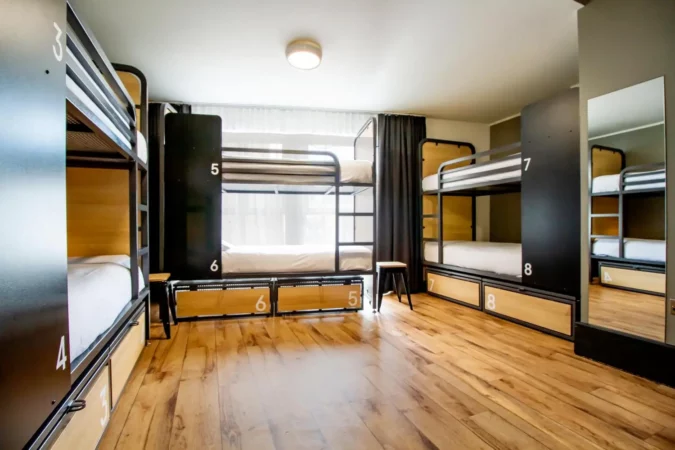One of the biggest draws of traveling around Europe is the relative ease with which you can get between cities and even countries. Whether you’re sticking to one country or hopping around the continent, train travel is a popular, convenient, and scenic way to get around. Trains will usually take you right to the city center, and the modern high-speed trains will zip you to your destination faster than some flights.
Unfortunately, while bus rides and flights around Europe usually offer budget-friendly options, train tickets are known to get pretty expensive. If you’re backpacking on a budget, read on for a list of our top tips for buying cheap European train tickets.
1. Book Your Tickets in Advance
The airline-style pricing of many long-distance European train tickets means that the further in advance you book, the less you pay. This is the case with intercity and high-speed trains in France, Italy, Spain, Portugal, and Sweden, as well as certain international trains traveling in and out of France.
Whenever you can, you definitely want to avoid purchasing your tickets the day of your trip. Not only will you be paying a premium price, but trains do occasionally fill up before departure. You’ll find that booking usually opens 60–90 days in advance of the departure date. However, some country’s websites allow booking even earlier, and Eurostar tickets can be purchased up to 180 days in advance.
2. Book Return Journeys
Some countries, including Britain, Ireland, and Spain, offer cheaper fares for one round-trip journey than for two one-way trips. Not only will you receive a lower rate for booking the two trips together, but booking your ride back as early as possible will also save you some money.
3. Take an Overnight Train
If you don’t have too much trouble catching z’s on the train, consider purchasing an overnight train ticket. Not only are bunks on sleeper trains generally cheaper than day-time tickets, but you’ll also save money by avoiding the cost of a night in a hotel or other accommodation.
4. Weigh the Worth of Interrail and Eurail Passes
Rail passes offer passengers unlimited travel on most European trains for a fixed price. They are essentially the same service, except Interrail Passes are only available to European residents, and Eurail Passes are for foreigners.
Some train passes for Europe come with unlimited train rides on a fixed number of travel days within one or two months. More expensive passes offer unlimited rides and travel days for periods of 15 days to three months. Although a rail pass might come in handy for travelers with flexible itineraries, it is unlikely to save you any money if you’re booking individual point-to-point tickets in advance.
It is still worth doing the math, especially since Eurail offers significant discounts for passengers under 28 and over 60, but rail passes are pretty pricey and you’ll have to take a lot of last-minute trips to make it worth the price. For example, a one-month Eurail Global Pass for an adult over 27 comes to a whopping €670.
5. Travel Off-Peak
Passengers traveling in the UK specifically can take advantage of off-peak fares, as the national railway system offers cheaper rates for traveling on trains that are not as busy. Various trains in France also offer cheaper tickets for traveling off hours, usually midday or midweek. You may also find cheaper fares across Europe for traveling in slower seasons like late fall and winter, similar to trends in flight prices.
6. Use a Train Ticket Comparison Site
The easiest way to find the cheapest train ticket, without significantly altering or restricting your plans, is to use a train ticket comparison site like Omio. Although they charge a very small service charge, they don’t mark up the price of the tickets, and their user-friendly platform makes it super easy to find the best rates. In contrast, many national railway websites are difficult to navigate due to imprecise translations and payment errors, which can end up costing you time and money in the long run.
7. Take Advantage of Child, Youth, and Senior Fares
Most countries in Europe offer discounts for young children, seniors, and teens and young adults. Train ticket comparison sites will have you fill out an age field when searching for your tickets, and if discounted fares are available, they will be offered automatically. So be sure to change the age field from the standard adult selection if you fall into one of the discounted groups. The age restrictions for children, youth, and seniors differ based on the country, and unless you’re traveling in Spain, infants don’t need tickets and can ride for free.
8. Check for Group Discounts
Several trains in Europe offer group discounts for parties traveling together. Reduced group rates are popular in countries like Germany and France, with DB Bahn offering discounts for groups of six or more and TGV offering discounts for groups of three or more. Trenitalia even offers a discount of up to 50% for groups of three to five people. Additional popular European railways that participate in group discounts include Eurostar, Thalys, National Rail, and Renfe.
9. Use a Railcard
Unlike Interrail and Eurail passes, country-specific railcards sometimes come with high-speed tickets, local train and bus trips, and even free entry to popular tourist sites. If you’re traveling around the same country a lot, the extra perks may make purchasing a country-specific railcard worth it.
10. Don’t Pay Extra for Reserved Seats
Although some train tickets include a seat reservation, most trains require you to pay an extra fee for choosing a seat. Fortunately, unless you’re booking at peak time, there will likely be a ton of unreserved seats available to choose from at the time of your trip. If you’re looking to save some money, consider skipping the seat reservation when you book.
11. Validate Your Ticket
If you’re planning to travel by train in Europe, you may pass through a country that requires you to validate your ticket before you board. This is especially important if you’re trying to save money, since presenting an unvalidated ticket to a conductor can result in a steep fine. For example, Trenitalia fines passengers €50 for presenting an unvalidated ticket. To validate your ticket, you can usually just insert it into one of the validation machines in the station, which will spit it back out with a date stamp.
Validating train tickets is especially common in France and Italy, although not all tickets require validation. Check the terms in your confirmation email or on the back of your physical ticket, or inquire with the information desk at the train station to be sure.
12. Visit Cheaper Destinations
If you’re on a budget and your plans are flexible, consider pursuing ticket prices before deciding where to go. Italy and the Czech Republic are known for offering slightly cheaper train tickets, while trains through Switzerland and France tend to be a bit pricey.
13. Book With No Refunds
Exploring Europe on rails is often a lot cheaper if you can commit to a specific train ticket with limited or no options for refunds and changes. Budget tickets are usually sold at final sale, while pricier options may come with full or partial refunds. Eurail Passes, for example, offer customers a choice between an 85% refund or an exchange for a different Eurail Pass. Trenitalia offers fares with up to a 60% discount for high-speed train tickets purchased in advance on a no-refund basis.
14. Take a Slower Train
As you might expect, high-speed train tickets can be especially pricey. If you have the time, you might be able to save some money by choosing a slower train with more stops.
15. Skip the Train
If you’re having trouble finding cheap train tickets for Europe, you may want to skip the train altogether and go with an alternate mode of transportation. Long-distance buses and flights across Europe are pretty affordable and, as long as you don’t have too much luggage, they can be just as convenient as a train ride. For instance, flying from Rome to Amsterdam on a budget airline like Ryanair can cost as little as €19, while taking the train will run you upwards of €67. Choosing a long-distance bus service like Flixbus or Eurolines is sometimes also more affordable than taking a train.
However, if you’re looking to avoid long bus rides, airports, and baggage fees, consider taking the scenic route and traveling in Europe by train. It might not always be the cheapest option, but it is certainly a good one, and there are plenty of ways to cut the cost of train tickets and stick to your budget.








Comments